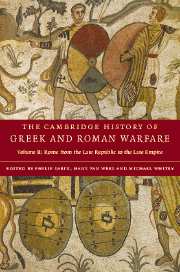Book contents
- Frontmatter
- Part I The Late Republic and the Principate
- Part II The later Roman Empire
- 7 International relations
- 8 Military forces
- 9 War
- 10 Battle
- 11 Warfare and the state
- 12 War and Society
- Chronological table
- Glossary
- List of ancient authors
- Bibliography
- Index of ancient passages cited
- General index
- Map 6. The provinces under Trajan."
- References
11 - Warfare and the state
from Part II - The later Roman Empire
Published online by Cambridge University Press: 28 March 2008
- Frontmatter
- Part I The Late Republic and the Principate
- Part II The later Roman Empire
- 7 International relations
- 8 Military forces
- 9 War
- 10 Battle
- 11 Warfare and the state
- 12 War and Society
- Chronological table
- Glossary
- List of ancient authors
- Bibliography
- Index of ancient passages cited
- General index
- Map 6. The provinces under Trajan."
- References
Summary
The relationship between war and the state was always a close one throughout Roman history, but never more so than during late antiquity. Indeed, one might legitimately talk in terms of an increased degree of militarization of the Roman state in this period. The impetus in this direction came during the mid-third century when the Empire faced severe strategic problems, both externally and internally. The empire’s frontiers suffered repeated breaches by a resurgent Persia to the east and by confederations of Germanic tribes to the north, while the inability of the central government to deal satisfactorily with these problems led to the emergence of independent ‘Gallic’ and ‘Palmyrene’ empires which broke away from centralized authority in the west and east respectively, raising the very real danger that the empire might fragment permanently. That this potential scenario did not occur was largely the result of the efforts of the so-called ‘soldier emperors’ of the late 260s, 270s and 280s who gradually reunited the empire and restored its fortunes. The most successful of these, Diocletian, expanded the size of the army and overhauled the Empire’s fiscal system to meet the army’s needs more closely. Symptomatic of this prioritization of military needs was the way in which, by the late third century, even service in the Empire’s civilian bureaucracy came to be referred to as a form of militia, the term traditionally used of service in the army, with civil servants being treated as a type of quasi-soldier complete with rations, uniform and military belt (cingulum).
Keywords
- Type
- Chapter
- Information
- The Cambridge History of Greek and Roman Warfare , pp. 379 - 423Publisher: Cambridge University PressPrint publication year: 2007
References
- 2
- Cited by

